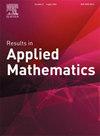Weakly coupled system of semilinear structural σ-evolution models with δ- visco-elastic damping
IF 1.4
Q2 MATHEMATICS, APPLIED
引用次数: 0
Abstract
This paper focuses on the study of global existence (in time) of solutions to a weakly coupled system of Cauchy problem for semilinear -evolution models with -visco-elastic damping. The system consists of two equations, one involving the function and the other involving the function . The equations are characterized by a classical power nonlinearity and a derivative-type nonlinearity. The main objective is to investigate the relationship between the regularity assumptions on the initial data and the range of permissible exponents and in the power nonlinearity. The paper considers the system in a spatial domain and a time domain , with specific conditions on the parameters , , , and , under the symmetry property as well as the exponents and . The initial data are required to satisfy certain conditions in terms of their integrability and Sobolev regularity.
具有δ粘弹性阻尼的半线性结构σ演化模型弱耦合系统
本文重点研究具有 δk-visco- 弹性阻尼的半线性 σk 演变模型的考希问题弱耦合系统的全局存在(时间)解。该系统由两个方程组成,一个涉及函数 u,另一个涉及函数 v。主要目的是研究初始数据的规则性假设与幂非线性中允许指数 p1 和 p2 的范围之间的关系。本文考虑了空间域 Rn 和时域(0,∞)中的系统,在对称性以及指数 p1 和 p2 的条件下,对参数 σ1、σ2、δ1 和 δ2 规定了具体条件。初始数据(u1,v1)需要满足一定的可整性和索波列夫正则性条件。
本文章由计算机程序翻译,如有差异,请以英文原文为准。
求助全文
约1分钟内获得全文
求助全文
来源期刊

Results in Applied Mathematics
Mathematics-Applied Mathematics
CiteScore
3.20
自引率
10.00%
发文量
50
审稿时长
23 days
 求助内容:
求助内容: 应助结果提醒方式:
应助结果提醒方式:


